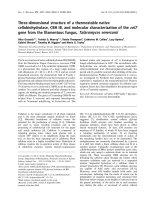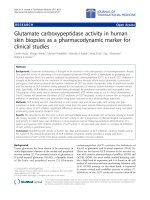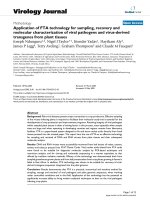INTERLEUKIN 6 RELEASE FROM t98g HUMAN GLIAL CELL LINE AS a PREDICTIVE MARKER FOR CHRONIC PAIN, AND THE CHARACTERIZATION OF SUBSTANCE(S) INVOLVED IN PAIN
Bạn đang xem bản rút gọn của tài liệu. Xem và tải ngay bản đầy đủ của tài liệu tại đây (1.43 MB, 136 trang )
INTERLEUKIN-6 RELEASE FROM T98G HUMAN
GLIAL CELL LINE AS A PREDICTIVE MARKER FOR
CHRONIC PAIN, AND THE CHARACTERIZATION OF
SUBSTANCE(S) INVOLVED IN CHRONIC PAIN
TAY SUAN ANNABEL
B.Sc. (Hons.), NUS
A THESIS SUBMITTED
FOR THE DEGREE OF MASTER OF SCIENCE
DEPARTMENT OF ANAESTHESIA
NATIONAL UNIVERSITY OF SINGAPORE
2013
i
Acknowledgements
I would like to express my sincere gratitude to my supervisor A/P Low
Chian Ming, for his support, advice and constant encouragement throughout my
research career at the National University of Singapore. Throughout the course of
my project, I have not only learned many laboratory techniques, but also learned
many invaluable life skills that will benefit me for life. I would also like to
express my gratitude to Prof Shinro Tachibana, for his guidance and support
throughout the course of my project. Without his directions, this work would not
have come to fruition. My heartfelt thanks are also due to A/P Liu Hern Choon
Eugene and Prof Lee Tat Leang, for supporting my work constantly, for their
helpful advice when things did not go well, and for helping me procure the
valuable samples from National University Hospital for the project. Thank you for
your supervision, guidance and support throughout my study. My sincere thanks
also goes out to Prof Toshiaki Minami for helping me procure the precious
samples from Osaka Medical University Hospital for my research work.
I would also like to express my heartfelt thanks to Mdm Li Chunmei for
her constant support, advice and encouragement. Thank you for all your help with
my HPLC work and other technical support. My sincere thanks go out to Ms
Wang Anni for her assistance in western blot and for brightening up my days as a
researcher. Thank you both so much for all the fun and laughter you have brought
to my days in the laboratory. I am also very grateful to Ms Jeyapriya Raja
Sundaram for her help and guidance in primary astrocyte culture and
immunocytochemistry, and for her kind advice throughout my study. My sincere
ii
thanks are also due to Mdm Karen Ho Ban Shian and Mrs Mariam Mathew
for their administrative support and assistance.
Lastly, I am grateful to my family and friends for their understanding,
endless support and encouragement throughout the course of my research work.
iii
Table of Contents
Acknowledgements
ii
Summary
ix
List of Tables
xi
List of Figures
xii
List of Abbreviations
xiv
List of Publications
xvii
List of Conference Papers
xvii
Chapter 1
Introduction
1.1 Chronic Pain
2
1.1.1 Epidemiology of Chronic Pain
2
1.1.2 Pathophysiology of Chronic Pain
3
1.1.2.1 Role of Glial Cells in Chronic Pain
4
1.1.2.1.1 T98G Cell Line as an in vitro Astrocytic Model
7
1.1.3 Treatment Strategies for Chronic Pain and their Challenges
8
1.1.4 Conditions related to Chronic Pain
11
1.1.4.1 Post-Herpetic Neuralgia (PHN)
11
1.1.4.2 Osteoarthritis
12
1.2 Neurotransmitters/Neuromodulators in Chronic Pain
1.2.1 Small Molecule Neurotransmitters
14
14
1.2.1.1 Amino Acids
14
1.2.1.2 Prostaglandins
16
1.2.2 Neuropeptides
16
1.2.2.1 Substance P
17
iv
1.2.2.2 Nociceptin/orphanin FQ and Nocistatin
1.2.3 Pro-inflammatory Cytokines
17
18
1.2.3.1 Tumour Necrosis Factor-α (TNF-α)
19
1.2.3.2 Interleukin-1β (IL-1β)
21
1.2.3.3 Interleukin-6 (IL-6)
22
1.3 Importance of Cerebrospinal Fluid (CSF) in Chronic Pain Research
1.3.1 Biological Markers in the CSF
1.4 Aim and Scope of Study
Chapter 2
23
24
26
Release of Pro-inflammatory Cytokines in T98G Cells Upon
Exposure to CSF of PHN Patients
2.1 Objectives of Chapter
29
2.2 Materials and Methods
31
2.2.1 Materials
31
2.2.2 CSF Samples
32
2.2.3 Cell Culture
33
2.2.4 Measurement of TNF-α, IL-1β and IL-6 Release
34
2.2.5 Measurement of Dexamethasone in CSF
35
2.2.6 Statistical Analyses
36
2.3 Results
37
2.3.1 TNF-α, IL-1β and IL-6 Releasing Activity in T98G Cells Upon
Exposure to CSF of PHN Patients
37
2.3.2 Comparison of IL-6 Releasing Activity Between CSF of Different
PHN Treatment Groups
39
2.3.3 Effect of in vitro Steroid on IL-6 Releasing Activity
2.4 Discussion
41
44
v
Chapter 3
Comparison of IL-6 Releasing Activity between CSF of Chronic
Pain Patients and Pain-free Patients
3.1 Objectives of Chapter
49
3.2 Materials and Methods
50
3.2.1 Materials
50
3.2.2 CSF Samples
50
3.2.3 Culture of Primary Astrocytes
51
3.2.4 Immunocytochemistry
52
3.2.5 Measurement of IL-6 in T98G and Primary Astrocyte Cell Culture
53
3.2.6 Statistical Analyses
53
3.3 Results
54
3.3.1 Comparison between PHN Therapy Effective, Therapy Ineffective
and Control Group
54
3.3.2 Comparison between Osteoarthritis and Control Group
56
3.3.3 IL-6 Release from Primary Astrocytes Upon Exposure to CSF of
Chronic Pain Patients
57
3.4 Discussion
Chapter 4
59
Purification of Protein-like Compounds from CSF of
Chronic Pain Patients
4.1 Objectives of Chapter
64
4.2 Materials and Methods
65
4.2.1 Materials
65
4.2.2 CSF Samples
65
4.2.3 Preliminary Experiments on CSF
66
4.2.3.1 Separation of CSF by Molecular Weight
vi
66
4.2.3.2 Treatment of CSF with Pronase
66
4.2.3.3 Measurement of IL-6 in T98G Cell Culture
67
4.2.4 Separation of CSF into Different Fractions
67
4.2.4.1 CSF Fractionation using HPLC
68
4.2.4.2 Measurement of IL-6 in T98G Cell Culture
70
4.2.5 IL-6 Release from T98G Cells When Exposed to Lignocaine and
Albumin
70
4.2.5 Statistical Analyses
71
4.3 Results
72
4.3.1 CSF Fraction >10 kDa Molecular Weight Triggered IL-6 Release in
T98G Cells
72
4.3.2 Pronase Attenuated IL-6 Release in T98G Cells
74
4.3.3 Separation of CSF by HPLC
75
4.3.3.1 HPLC on Pooled CSF
75
4.3.3.2 HPLC on Pooled Active Fractions
77
4.3.4 Comparison between Chromatograms Obtained from HPLC of
Osteoarthritis CSF and Control CSF
4.3.5 Effects of Lignocaine and Albumin on IL-6 Release
4.4 Discussion
Chapter 5
80
81
83
Signaling Mechanism of Chronic Pain in the T98G Cell System
5.1 Objectives of Chapter
89
5.2 Materials and Methods
90
5.2.1 Materials
90
5.2.2 CSF Samples
90
5.2.3 Cell Culture and NF-κB Inhibition
91
vii
5.2.4 Cell Fractionation and Cell Lysis
91
5.2.5 Western Blot
93
5.2.6 Statistical Analyses
93
5.3 Results
95
5.3.1 Inhibition of NF-κB led to Reduced IL-6 Release in T98G Cells
95
5.3.2 NF-κB Activation in T98G Cells Upon Exposure to CSF of
Chronic Pain Patients
97
5.4 Discussion
Chapter 6
99
Conclusion and Future Directions
6.1 Conclusion
104
6.2 Limitations of Study
106
6.3 Future Directions
107
References
109
viii
Summary
Besides neurons, the central nervous system (CNS) consists of glial cells,
which are mainly microglia and astrocytes. Chronic pain is classically viewed as
being mediated solely by neurons, but there is mounting evidence that glial cells
also play a part. Glial cells, responding to stimulation by neurotransmitters and
peptides, are activated and release pain-enhancing substances like proinflammatory cytokines. These cytokines have been shown to play a role in
enhancing pain by their actions in the spinal cord.
This research work focuses firstly on investigating pro-inflammatory
cytokine release in a cell culture system as a potential marker for chronic pain.
Two conditions related to chronic pain were studied: post-herpetic neuralgia
(PHN) and osteroarthritis. Cerebrospinal fluid (CSF) from patients suffering from
either condition was used to trigger astrocytic cell line T98G cultures, and
subsequent pro-inflammatory cytokine release was measured by enzyme-linked
immunosorbent assay (ELISA). IL-6 release in the chronic pain patient groups
was found to be significantly higher compared to pain-free controls, as well as in
the PHN patient group whose steroid treatment was ineffective compared to those
whose treatment was effective. CSF samples collected before steroid treatment
also triggered higher IL-6 release than after treatment samples. These in vitro tests
provide an objective evaluation on the extent of chronic pain as well as the
efficacy of steroid therapy.
ix
Secondly, we attempted to separate and isolate pain-related substances in
chronic pain patients’ CSF, making use of the in vitro T98G cell system
established earlier. The CSF was separated by a two-step high performance liquid
chromatography (HPLC) technique, and the fractions that triggered IL-6 release
in T98G cells were isolated. We narrowed down to three peaks that could trigger
IL-6 release and these peaks would be subjected to future mass spectrometry
analysis to identify the protein-like substances in the CSF, which could be
potential markers for chronic pain. Lastly, we attempted to elucidate the IL-6
signaling pathway in this in vitro model of chronic pain. NF-κB inhibition studies
and western blot analysis confirmed that NF-κB acts upstream of IL-6 in this
T98G cell system.
In conclusion, we have established an effective in vitro assay system to
quantify chronic pain utilizing CSF and have taken the first steps in isolating
pain-related protein substances in the CSF of chronic pain patients. In an attempt
to better understand the complex mechanisms, we hope to contribute to the
management of unrelenting chronic pain.
x
List of Tables
Table 1-1
Common pharmacological treatments for chronic pain
10
Table 2-1
Patient data (PHN)
36
Table 3-1
Patient data (Control, PHN and Osteoarthritis)
53
xi
List of Figures
Figure 1-1
Schematic diagram of how chronic pain is transmitted
Figure 2-1
TNF-α, IL-1β and IL-6 release in T98G cells upon addition
of PHN CSF
37
Figure 2-2
Comparisons in IL-6 release between before and after
treatment groups, and between therapy effective and
ineffective groups
39
Figure 2-3
IL-6 release in T98G cells upon addition of PHN CSF and
methylprednisolone
41
Figure 2-4
Dexamethasone analyses in CSF of PHN patients
42
Figure 3-1
Comparisons in IL-6 release between control, PHN therapy
effective and PHN therapy ineffective groups
54
Figure 3-2
Comparison in IL-6 release between control and
osteoarthritis groups
55
Figure 3-3
Immunocytochemical analysis of primary astrocytes
56
Figure 3-4
IL-6 release in primary astrocytes upon addition of
PHN CSF
57
Figure 4-1
IL-6 release in T98G cells upon addition of pooled
osteoarthritis CSF of < 10 kDa molecular weight CSF and
pooled osteoarthritis CSF of > 10 kDa molecular weight
71
Figure 4-2
IL-6 release in T98G cells upon addition of pooled
osteoarthritis CSF pre-treated with pronase
72
Figure 4-3
HPLC of pooled osteoarthritis CSF and IL-6 releasing
activity of the peaks
73
Figure 4-4
HPLC of pooled active fractions from previous HPLC
run, and IL-6 releasing activity of the peaks
76
Figure 4-5
Chromatograms obtained from HPLC of (A) pooled
osteoarthritis CSF and (B) pooled pain-free control CSF
78
Figure 4-6
IL-6 release in T98G cells upon addition of lignocaine
79
Figure 4-7
IL-6 release in T98G cells upon addition of albumin
80
Figure 5-1
Effect of NF-κB inhibitor Bay 11-7082 on IL-6 release
in T98G cells upon addition of osteoarthritis CSF
92
xii
6
Figure 5-2
Effect of NF-κB inhibitor Bay 11-7082 on IL-6 release
in T98G cells upon addition of control CSF
93
Figure 5-3
Western blot demonstrating NF-κB activation
95
Figure 5-4
Possible signaling pathway of IL-6 release in T98G cells
99
xiii
List of Abbreviations
ATCC
American Type Culture Collection
AUFS
Absorbance Units Full Scale
CER-1
Cytoplasmic Fractionation Reagent
CCI
Chronic Constriction Model
CNS
Central Nervous System
COX
Cyclooxygenase
CRPS
Complex Regional Pain Syndrome
CSF
Cerebrospinal Fluid
DAPI
4',6-diamidino-2-phenylindole
DMEM
Dulbecco's Modified Eagle Medium
DRG
Dorsal Root Ganglia
DSRB
Domain Specific Review Board
DTT
Dithiothreitol
EBSS
Earle's Balanced Salt Solution
ECM
Extra-cellular Matrix
ELISA
Enzyme-linked Immunosorbent Assay
EMEM
Eagle’s Minimum Essential Medium
FBS
Fetal Bovine Serum
GABA
γ-amino-butyric Acid
GFAP
Glial Fibrillary Acidic Protein
HPLC
High Performance Liquid Chromatography
HRP
Horseradish Peroxidase
xiv
IL-1
Interleukin-1
IL-1β
Interleukin-1β
IL-6
Interleukin-6
IL-8
Interleukin-8
IL-10
Interleukin-10
IL-18
Interleukin-18
i.t.
Intrathecal
L-PGDS
Lipocalin-type Prostaglandin D Synthase
LPS
Lipopolysaccharides
MALDI-TOF Matrix-assisted Laser Desorption/ionization–time-of-flight
NER-1
Nuclear Fractionation Reagent
NF-κB
Nuclear Factor-Kappa-B
NK1
Neurokinin 1
NMDA
N-methyl-D-aspartic Acid
N/OFQ
Nociceptin/orphanin FQ
NSAIDs
Non-steroidal Anti-inflammatory Drugs
NST
Nocistatin
PBS
Phosphate Buffered Saline
PBST
PBS with 0.1% v/v Tween-20
PGE2
Prostaglandin E2
PHN
Post-herpetic Neuralgia
PKA
Protein Kinase A
PKC
Protein Kinase C
xv
PMSF
Phenylmethylsulfonyl Fluoride
PNS
Peripheral Nervous System
ppN/OFQ
Prepronociceptin
PVDF
Polyvinylidene Difluoride
SEM
Standard Error of Mean
sIL-6R
Soluble IL-6 Receptor
SSNRIs
Selective Serotonin and Norepinephrine Reuptake Inhibitors
TCAs
Tricyclic Antidepressants
TFA
Trifluoroacetic Acid
TNF-α
Tumour Necrosis Factor-α
VAS
Visual Analogue Scale
WHO
World Health Organization
xvi
List of Publications
A.S. Tay, E.H. Liu, T.L. Lee, S. Miyazaki, W. Nishimura, T. Minami, C.-M. Low,
S. Tachibana, Cerebrospinal fluid of postherpetic neuralgia patients induced
interleukin-6 release in human glial cell-line T98G. (Manuscript submitted)
List of Conference Papers
A.S. Tay, C. Li, A. Wang, T.L. Lee, S. Tachibana, C.-M.Low, Cerebrospinal fluid
from post-herpetic neuralgia Japanese patients triggers interleukin-6 release in
glioblastoma cells. 2nd Singapore-Duke Anaesthesia Update (Singapore, 2010)
Poster presentation
A.S. Tay, C. Li, A. Wang, E.H. Liu, T.L. Lee, S. Chiang, S. Fujiwara, W.
Nishimura, T. Minami, C.-M. Low, S. Tachibana, Cerebrospinal fluid from postherpetic neuralgia Japanese patients triggers interleukin-6 release in glioblastoma
cells, J. Neurochem. 115 Supplement 1 (2010). 10th Biennial Meeting of the
Asian-Pacific Society of Neurochemistry (Phuket, Thailand, 2010) Poster
presentation
A.S. Tay, E.H. Liu, T.L. Lee, S. Miyazaki, W. Nishimura, T. Minami, C.-M. Low,
S. Tachibana, Interleukin-6 release from human glial cell line T98G as a
predictive marker on the effectiveness of steroid therapy in reducing neuropathic
pain of post-herpetic neuralgia patients. Yong Loo Lin School of Medicine 2nd
Annual Graduate Scientific Congress (Singapore, 2012) Oral presentation
xvii
Chapter 1
Introduction
1
1.1 Chronic Pain
The International Association for the Study of Pain defines chronic pain as
pain that persists for at least 3 months. Chronic pain is normally triggered by
injury or disease, which damages the nervous system in such a way that it is
unable to restore its normal physiological functions to homeostatic levels. It can
persist for months or years, long after the original injury has healed (Gao and Ji,
2010). Chronic pain is heterogeneous, and multiple molecular and cellular
mechanisms act in combination within the peripheral nervous system (PNS) and
central nervous system (CNS) to produce the chronic pain (Scholz and Woolf,
2002).
1.1.1 Epidemiology of Chronic Pain
Chronic pain has become a major healthcare challenge as it interferes with
normal daily life. The World Health Organization (WHO) approximates that one
in five people worldwide experiences chronic pain. In a large-scale survey
involving 16 countries, 19% of respondents over 18 years old had suffered pain
for more than 6 months. 61% of these chronic pain sufferers were unable to work
outside the home, and 19% had lost their jobs. 40% of them had insufficient pain
management and only 2% were seeing a pain specialist (Breivik et al., 2006).
A study carried out in Singapore in 2009 showed that the prevalence of
chronic pain was 8.7%. Chronic pain afflicted women at a higher rate than men,
and the prevalence increased sharply beyond 65 years of age. Although a
2
seemingly lower prevalence of chronic pain was seen in this study, it remains a
healthcare problem of high importance, due to a rapidly ageing population in
many developed countries including Singapore, and is likely to consume an
increasingly large amount of healthcare resources within the next few years (Yeo
and Tay, 2009).
1.1.2 Pathophysiology of Chronic Pain
Chronic pain can be classified as either nociceptive or neuropathic.
Nociceptive pain is derived from mechanical, chemical or thermal irritation to the
peripheral sensory nerves, and is typically well-localized. Neuropathic pain, on
the other hand, is pain initiated by damage to or a lesion of the nervous system,
and is characterized by poor localization (Goucke, 2003).
Chronic pain results from the development of neural plasticity in the PNS
and CNS. It was traditionally believed that only neurons and their neural circuits
were responsible for pain development and maintenance. Hence current
therapeutics for chronic pain focuses on neuronal targets, which include Nmethyl-D-aspartic acid (NMDA) receptor antagonists and opioid analgesics. Such
therapies provide transient pain relief and do not resolve the underlying
pathological processes that lead to chronic pain. Hence, studies on non-neuronal
cells, in particularly glial cells in chronic pain conditions, have increased
tremendously in recent years.
3
1.1.2.1 Role of Glial Cells in Chronic Pain
Recent studies and review articles have highlighted a communication
cross-talk that exists between the immune system and the nervous system (Scholz
and Woolf, 2007). Neurons and glial cells in the nervous system have close
interactions with each other on a cellular and molecular level. Injury to peripheral
nerves triggers an inflammatory response in peripheral glia and immune cells. The
vital role of inflammation in the development of chronic pain is demonstrated in a
study whereby injection of pro-inflammatory agents such as carrageenan or
complete Freund’s adjuvant around the sciatic nerve induced mechanical
allodynia in animal models (Sorkin and Schafers, 2007). The peripheral
inflammatory response then sets off a series of downstream reactions through the
release of neurotransmitters or neuromodulators from primary afferents. These
substances in turn lead to activation of glial cells that are in close proximity to the
afferent neuron terminals (Vallejo et al., 2010).
Glial cells, forming 70% of the total cell population in the brain and spinal
cord, have long been viewed as performing mainly neuronal housekeeping and
support functions, providing insulation and protection to the neurons. They do not
have axons, and hence they have been perceived to have no role in nerve signal
transmission. However, this view has slowly been changing. Pathological pain is
classically viewed as being mediated solely by neurons, but there is mounting
evidence that glial cells also play a part in exaggerated pain states created by
inflammation and neuropathy (Hashizume et al., 2000; Watkins and Maier, 2002).
Astrocytes, in particular, play an important role in pain processing. They are the
4
most abundant cells in the CNS (constituting 40-50% of all glial cells) in terms of
number and volume, forming networks with themselves via gap junctions and
making very close contacts with neuronal synapses and blood vessels (Halassa et
al., 2007). Astrocytes express receptors for numerous neurotransmitters,
neuroactive substances and amino acids, and hence provide support and
nourishment for neurons as well as regulate the external chemical environment
during synaptic transmission (Verkhratsky and Steinhauser, 2000; Hanson and
Ronnback, 2004).
In normal physiological conditions, glial cells are in a quiescent state. In
most cases of early glial response to injury or disease conditions, activation of
microglia occurs first. Activated microglia display a change in surface markers
and membrane proteins, and this triggers the production and release of painenhancing substances such as reactive oxygen species, excitatory amino acids,
nitric oxide, prostaglandins and pro-inflammatory cytokines (Wieseler-Frank,
Maier and Watkins, 2004). This subsequently leads to activation and proliferation
of astrocytes, correlating with the release of even more pain enhancing substances.
These substances modulate pain processing by influencing either presynaptic
release of neurotransmitters and/or postsynaptic excitability, leading to
persistence in hypersensitivity and chronic pain (Guo et al., 2007). Figure 1-1
shows the schematic diagram of chronic pain transmission.
5
Figure 1-1 Schematic diagram of how chronic pain is transmitted. After
receiving a pain stimulus, peripheral neurons transmit signals to the primary
afferent neuron, causing the release of neurotransmitters and neuromodulators that
activate the receptors on microglia and astrocytes. The glial cells are activated and
release pro-inflammatory cytokines and other pain enhancing substances. This
affects the presynaptic release of neurotransmitters, postsynaptic excitability, as
well as a self-propagating mechanism of enhanced production of pain enhancing
substances by the glial cells.
6
Astrocytic reaction is more persistent than microglial reaction after nerve
injury, lasting more than 150 days after nerve injury. Activation of astrocytes
results in prolongation of the pain state, and is accompanied by a reduction in
microglial activity over time (Tanga et al., 2004). Thus, microglia are involved in
the early development of chronic pain, while astrocytes function in sustaining the
pain (Vallejo et al., 2010). An interesting finding was that nerve injury induces an
increase in interleukin-18 (IL-18) and IL-18 receptors in activated microglia and
astrocytes respectively, suggesting an interaction between microglia and
astrocytes in the physiology of chronic pain (Miyoshi et al., 2008).
However in some cases, astrocytes are activated without microglial
activation, and are shown to be sufficient on their own to produce chronic pain.
Davies et al. (2008) showed that transplantation of astrocytes derived from glialrestricted precursor cells triggered the onset of mechanical allodynia and thermal
hyperalgesia after spinal cord injury in rats. Hald et al. (2009) also demonstrated
that development of hypersensitivity and activation of astrocytes occurred without
microglial activation in chronic pain mouse models.
1.1.2.1.1 T98G Cell Line as an in vitro Astrocytic Model
The cell line used in this project is the T98G human glial cell line. T98G
cell line is a derivative of glioblastoma and is of astrocytic origin. T98G cells
have the transformed characteristics of immortality and anchorage independence.
However at the same time, they act like normal human cells in that they become
7









